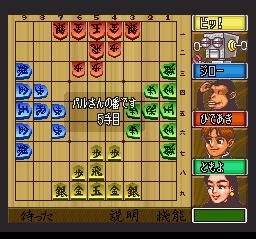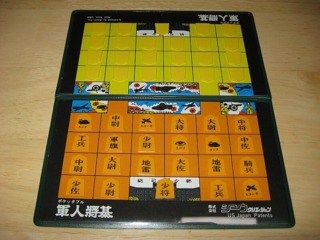Overview
Shogi, also known by its proper romanization shōgi (or shougi), is a traditional Japanese board game and a variation of the game of chess (to the point that it is sometimes called "Japanese chess"). Loosely translated to "general's game", shogi has two players taking turns moving their military-themed pieces (which are usually flat pentagonal pieces etched with kanji) around the rectangular game board in an effort to capture the opposing player's king. The game is best known for its modern "drop rule", which allows captured pieces to be redeployed as part of the captor's forces (which is likely due to the practice of mercenaries switching loyalties to prevent their execution).
Similar to Western chess and the Chinese board game xiangqi, the earliest known ancestor to shogi is the ancient game chaturanga, which is believed to have originated in 6th century India. It is unknown how the game was brought into Japan, with the earliest documents indicating the game's existence tracing back to the 10th-11th century. Several variations of the game have been invented since its origin, usually affecting the size of the game board and the piece selection. The modern form of shogi (which is simply called "shogi") was standardized in the 16th century and is based on the 9×9 variant sho shogi.
Along with go, standard shogi is one of the most well-known board games throughout Japan, is still tied to traditional Japanese culture, and is played competitively. As with go, mahjong, and hanafuda, the standard form of shogi has received numerous video game adaptations, either as their own separate game (which are mostly Japanese-exclusive) or as part of a board game collection.
Pieces
Shogi Variants
Standard Rules
These variants use standard shogi rules, usually with a different board size and a new piece variation.
Mini Shogi
A small-board variant, mini shogi (also known as gogo shōgi, 5-go shōgi, or minishogi) uses a 5×5 game board and only six pieces per player (one of each of the following: king, rook, bishop, gold general, silver general, and pawn).
It is believed to have been invented (or rediscovered) sometime around 1970, and is notable for its inclusion in the game collection Clubhouse Games: 51 Worldwide Classics.
Yonin Shogi

A four-player variant, yonin shogi ("four-man shogi", also known as 4-nin shōgi) puts each player's nine pieces (1 king, 1 rook, 2 gold generals, 2 silver generals, and 3 pawns) in a triangular arrangement on their side of the board. Turns are played clockwise, and players are eliminated when they are in checkmate (placing their pieces under control of the mating player). Games can be played in free-for-all or in teams of two.
This variant was invented in 1993 and received its own dedicated 1995 Super Famicom adaptation.
Unique Rules
These variants use rules that are drastically different.
Gunjin Shogi

One of the most well-known shogi variants, gunjin shogi ("military shogi") uses a different type of board, different types of pieces, and unique rules involving board setup, hidden pieces, and piece strength.
Players start the game by arranging their pieces on each of their board's spaces face-down, hidden from the opponent. The objective is to capture pieces through attacking and defending, with the end goal being to either occupy the enemy player's two-tile "headquarters" space with one of their higher-rank pieces, destroy all opposing pieces, or, in some rule variations, to defeat the opponent's highest-ranking piece.
Each piece has their own specific orthogonal movement pattern, and players cannot use the "drop rule". In addition, they each have their own "strength", which is what determines which of the two pieces are captured (allowing defending pieces to capture attacking pieces). These pieces are:
- General (大将) > Lieutenant General (中将) > Major General (少将) - Can move one square in any direction. Defeats all pieces with a lower rank, as well as every other piece except the Mine and, for the highest-ranked General, the Spy. Can capture the headquarters space.
- Colonel (大佐) > Lieutenant Colonel (中佐) > Major (少佐) - Can move one square in any direction. Defeats all pieces with a lower rank, and can defeat all other pieces except the Generals, the Plane, the Tank, and the Mine. Can capture the headquarters space.
- Captain (大尉) > First Lieutenant (中尉) > Second Lieutenant (少尉) - Can move one square in any direction. Defeats all pieces with a lower rank, and can defeat all other pieces except the Generals, higher Officers, the Plane, the Tank, and the Mine.
- Plane (飛行機) - Can move any number of squares forwards or backwards, as well as one space left or right. Can ignore the entrance rule while moving and can jump over any number of pieces along the way. Can defeat all other pieces except the Generals.
- Tank (タンク) - Can move one square in any direction, or two squares forward. Can defeat all except the Generals, the Plane, the Engineer, and the Mine.
- Cavalry (騎兵) - Can move one square in any direction, or two squares forward. Can only defeat the Engineer and the Spy.
- Engineer (工兵) - Can move any number of squares in any direction. Can only defeat the Tank, the Spy, and the Mine.
- Spy (スパイ) - Can move one square in any direction. Can only defeat the highest-ranked General.
- Mine (地雷) - Cannot move. Ties with all pieces except the Plane and the Engineer. Cannot be placed at the entrance spaces.
- Flag (軍旗) - Cannot move. Shares the same strength as the piece in the row and column directly behind it, immediately losing if there is no piece behind it. Cannot be placed at the entrance spaces and cannot be placed at the back row.
There are multiple variations to board size and piece count, with the most common being the 8×6 game board with 23 pieces (1 of each General and higher Officer, 2 of each lower Officer, 2 Planes, 2 Tanks, 1 Cavalry, 2 Engineers, 1 Spy, 2 Mines, and 1 Flag). The center of the board has multiple "entrances" by which most pieces can only go through to move-between boards. The game traditionally uses a third player as a referee, which secretly determines the outcome of each attack. Some variations use new pieces, such as a Marshal.
Its origins are unknown, with the earliest mention of the game taking place in the year 1895. It is notable for being a precursor to the French game L'Attaque, which led to the Western board game Stratego. There have been several video game adaptations of gunjin shogi, most of which are Japan-exclusive, and has been included in Clubhouse Games under the name "Field Tactics".
Hasami Shogi
Rather than different types of pieces, hasami shogi ("scissors shogi") uses only one type of piece that can be moved any number of empty spaces orthogonally, similar to rooks in standard shogi, and can only be captured when surrounded by two opposing pieces (either by-rank or by-file, or by both when the piece is in a corner). It uses a standard 9×9 game board, gives each player a row of nine pieces, and tasks players with capturing all but one of the opposing player's pieces.
A variation, known as dai hasami shogi, instead gives players two rows of nine pieces each and tasks players with forming an uninterrupted orthogonal line of five pieces outside of their starting area. This version allows players to jump a piece over another.
Its origin are unknown, although it shares some of its rules with the Roman game latrunculi and the Egyptian game Seega. The standard version of hasami shogi is notable for its inclusion in the game collections Daredemo Asobitaizen and Clubhouse Games.
Log in to comment